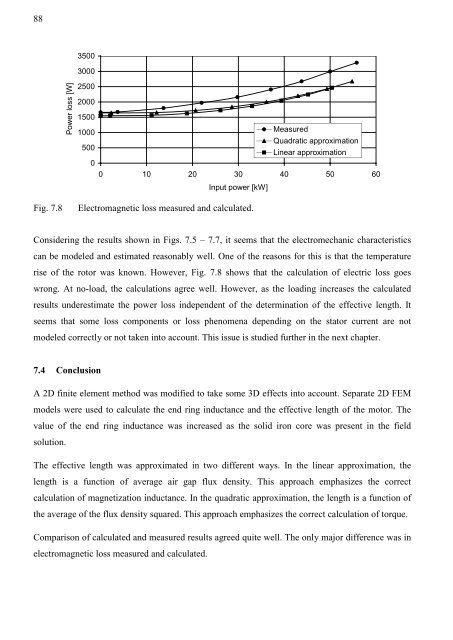Design and Voltage Supply of High-Speed Induction - Aaltodoc
Design and Voltage Supply of High-Speed Induction - Aaltodoc
Design and Voltage Supply of High-Speed Induction - Aaltodoc
Create successful ePaper yourself
Turn your PDF publications into a flip-book with our unique Google optimized e-Paper software.
88<br />
Considering the results shown in Figs. 7.5 – 7.7, it seems that the electromechanic characteristics<br />
can be modeled <strong>and</strong> estimated reasonably well. One <strong>of</strong> the reasons for this is that the temperature<br />
rise <strong>of</strong> the rotor was known. However, Fig. 7.8 shows that the calculation <strong>of</strong> electric loss goes<br />
wrong. At no-load, the calculations agree well. However, as the loading increases the calculated<br />
results underestimate the power loss independent <strong>of</strong> the determination <strong>of</strong> the effective length. It<br />
seems that some loss components or loss phenomena depending on the stator current are not<br />
modeled correctly or not taken into account. This issue is studied further in the next chapter.<br />
7.4 Conclusion<br />
A 2D finite element method was modified to take some 3D effects into account. Separate 2D FEM<br />
models were used to calculate the end ring inductance <strong>and</strong> the effective length <strong>of</strong> the motor. The<br />
value <strong>of</strong> the end ring inductance was increased as the solid iron core was present in the field<br />
solution.<br />
Power loss [W]<br />
3500<br />
3000<br />
2500<br />
2000<br />
1500<br />
1000<br />
500<br />
0<br />
Measured<br />
Quadratic approximation<br />
Linear approximation<br />
0 10 20 30<br />
Input power [kW]<br />
40 50 60<br />
Fig. 7.8 Electromagnetic loss measured <strong>and</strong> calculated.<br />
The effective length was approximated in two different ways. In the linear approximation, the<br />
length is a function <strong>of</strong> average air gap flux density. This approach emphasizes the correct<br />
calculation <strong>of</strong> magnetization inductance. In the quadratic approximation, the length is a function <strong>of</strong><br />
the average <strong>of</strong> the flux density squared. This approach emphasizes the correct calculation <strong>of</strong> torque.<br />
Comparison <strong>of</strong> calculated <strong>and</strong> measured results agreed quite well. The only major difference was in<br />
electromagnetic loss measured <strong>and</strong> calculated.
















